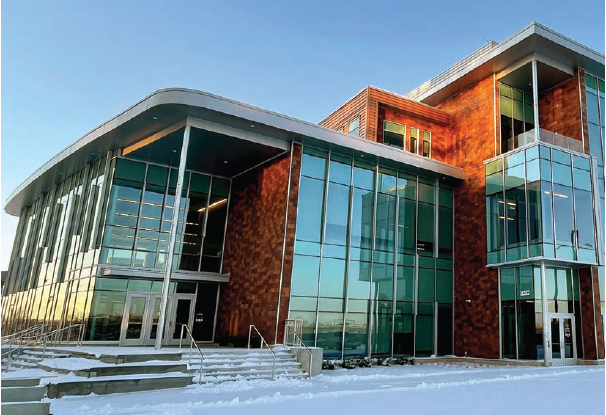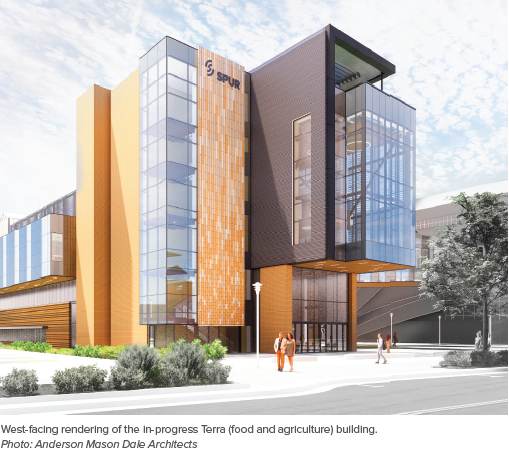CSU Spur Brings Learning To Life For Everyone
By Gary Polakovic

Spur, defined (verb): “Something that makes you want to do something or that causes something to happen.” – Merriam- Webster dictionary.
In three new science-themed buildings near downtown Denver, Colorado State University System is building a portal for public engagement to help solve big global challenges in food, water, and health. With CSU Spur, the CSU System is staking a claim to sustainability for the 21st century. It’s a high-visibility and big-inspiration campus, situated just east of the junction of interstates 25 and 70. Construction is well underway, with the first building (Vida) opened Jan. 7, to be followed by the Terra and Hydra buildings later this year.
Steel and stone now, the campus is in fact connective tissue. It is a bridge between urban and rural worlds, between Colorado and the planet. It is science writ large into an urban center amid a Western landscape. It’s a people’s classroom, where science comes alive and is accessible to the public. It’s a showcase for a sustainable society, putting into practice principles taught in textbooks. It’s a place of melting boundaries among science and art, recreation, and ideation.
For CSU System Chancellor Tony Frank, the Spur campus is a long awaited triumph that underscores the expanding reach of the state’s higher education system.
“As this campus starts to come to life, we’re excited to share it with you. And we’re even more excited to open our doors in 2022 and to bring all the innovation, creativity, and fun of our three higher education institutions – CSU, CSU Pueblo, and CSU Global – directly to you,” Frank said.
CSU is one of the nation’s top-tier research institutions, with more than $447.2 million in annual research expenditures. The University is a national leader in sustainability research and facilities operations with a mandate to turn knowledge into practical solutions for the community. CSU is home to a nationally recognized veterinary program as well as the One Health Institute, where scientists study an ecosystem of health issues across human populations, wildlife and domestic animals, and the built and urban environments.
“The Spur campus will provide a window for Colorado and global visitors to see and appreciate how a top-tier research institution benefits the community and CSU system,” said Alan Rudolph, vice president for research at CSU
Spur will play to CSU’s strengths.
The Denver campus will consist of three main buildings focused on challenges to human and animal health, water, and food and agriculture.
The first building, Vida, is now open and will focus on animal and human health. Among its features is the second location of the Temple Grandin Equine Center, providing equine-assisted services, a Dumb Friends League veterinary hospital for companion animals to receive subsidized care, and underwater treadmills for horse rehabilitation. The entire CSU Spur campus will be open by the end of the year.

The Vida (human and animal health) building recently opened in January. Photo: CSU System
The second building to be completed, Terra, will focus on food and agriculture. Among its features will be rooftop greenhouses, a food lab, a teaching and commissary kitchen, and vertical gardens. Terra will be open to the public year-round starting in April.
The final building, Hydro, focuses on water. Among its features will be Denver Water’s new Water Quality Lab, a direct connection to the South Platte River, event space, artist studios, and a farm to- table café. Hydro will be completed and open to the public in November.
Opportunities for learning and interaction with science will be up close and personal at Spur.
For example, people can see dogs and cats in surgery and watch people and horses interact at the Temple Grandin Equine Center’s equine assisted services. Kids can get their hands dirty in gardens and interactive exhibits and check out a growing green roof and rooftop garden to learn where food comes from before eating at the Spur café.
The center will offer youth programs, community classes, certifications, and select master’s degrees, providing something for learners of all ages. In a single day at Spur, a visitor could check out a laboratory, veterinary clinic, market, museum, art studio, classroom, garden, and innovation center.
There will be concerts, festivals, conferences and cultural events, family activities, and dining. CSU Spur is home to eight major art installations, a flexible theater space, and studios to watch artists at work. Visitors can grab coffee, lunch, or a post-work cocktail.
The buildings are designed to meet LEED Gold standards while much of the heating will come from an underground wastewater heat recovery system, and on-site collected gray water will flush toilets. The site will include natural areas and a restored portion of the river, as well as murals and public art.
Spur is a $200 million state-funded campus-within-a-campus, as it’s part of the larger National Western Center, a 250-acre redevelopment project that will host the National Western Stock Show annually and be a year-round destination for concerts, conferences, and farmers markets.
Partners of the CSU System include the city and county of Denver, Western Stock Show Association, Denver Museum of Nature and Science, and History Colorado – the founding partners of the National Western Center redevelopment. Also, Denver Water and Dumb Friends League have become major programmatic partners within the CSU Spur buildings, and Together We Grow, the North American Agricultural Advisory Network, and the Salazar Center for North American Conservation will also be headquartered at CSU Spur.

At its core, Spur seeks to prepare people to reckon with the biggest issues of the 21st century. By the numbers, much of the world lacks adequate drinking water, and climate change curtailed crop yields by 10% in the early 2000s. In the next 25 years, urban population growth is forecast to surge by 50%, prompting a 56% increase in demand in global energy consumption.
Said Frank: “Food, water, the environment, energy, human health – these are the great global challenges of our day; these are the things that are at the sweet spot of what a land-grant university does. We’ve got great researchers in all of these areas who can study these issues in overlapping ways.”
In support of Spur, the Colorado legislature allocated $200 million to the capital construction of the campus and $50 million to CSU for facilities at the Fort Collins campus, including the Health Education Outreach Center, C. Wayne McIlwraith Translational Medicine Institute, and Johnson Family Equine Hospital.